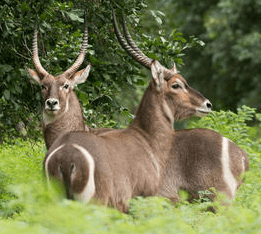Introduction
The Waterbuck is a large antelope species found in sub-Saharan Africa. Known for its impressive appearance and habitat preference near water sources, it is a popular sighting among wildlife enthusiasts.
Physical Features
Waterbucks are robust animals with a distinctive shaggy coat. The males are larger than females, weight (female) 205 – 250 kg and weight (male) 250 – 270 kg. Males are the only ones that will have horns, which are long and curved with ridges or rings along them. The colour of the upper body is brown-grey flecked with white or grey hairs

Waterbuck
Habitat and Behavior
As the name suggests, waterbucks are strongly associated with water-rich environments such as grasslands, savannas, and floodplains. They are excellent swimmers and often take refuge in water when threatened by predators, such as lions or hyenas. Waterbucks form small herds composed of females and their offspring, while males are more solitary.
Where Waterbuck Are Found
In South Africa the Waterbuck are distributed along the major drainage systems of Mpumalanga, Northern Province and northern KwaZulu-Natal. Recently re-introduced at St Lucia and Itala game reserves in KwaZulu-Natal.
Diet
Waterbucks are predominantly grazers, feeding on grasses and aquatic vegetation. Their specialized digestive system allows them to extract nutrients from tough and coarse plant material. They are known to browse on shrubs and trees on occasion as well.
Predators
Lions, cheetahs, leopards, crocodiles, African wild dogs and hyenas.
Conservation Status
The Waterbuck population is currently stable, and the species is not considered endangered. However, habitat loss and hunting pose threats to their long-term survival. Conservation efforts focus on protecting their natural habitats and ensuring sustainable hunting practices.
Interesting Facts
- Waterbucks have a distinct oily secretion that acts as a waterproofing agent for their fur.
- The white ring on the rump of a Waterbuck is thought to act as a “follow me” signal when they flee, helping the herd to stay together.
- Waterbucks are primarily active during the early morning and late afternoon, avoiding the hottest parts of the day.
- Unlike many other antelope species, Waterbucks do not have a specific breeding season. Mating can occur throughout the year.
- Male Waterbucks engage in impressive displays of dominance to establish territories and attract mates. These displays involve running, leaping, and showing off their horns.
- Waterbucks have excellent hearing and eyesight, which help them detect potential threats in their surroundings.
- Their coat coloration can vary among individuals, ranging from grayish-brown to reddish-brown, with a white throat and white patches above the eyes.
- Waterbucks are ruminants, meaning they have a specialized digestive system that allows them to ferment and break down cellulose-rich plant material.
- They have specialized scent glands located under their eyes, which they use to mark their territories and communicate with other individuals.
- Waterbucks have a lifespan of around 15 years in the wild.
- Males join up with bachelor herds once they develop horns at around 7 to 9 months old.
Return to Antelope page.
